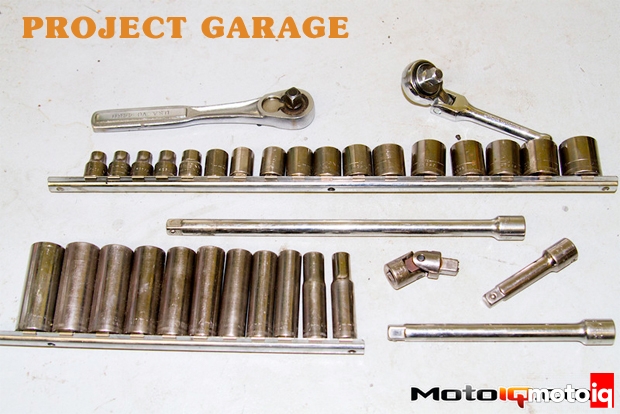,
 |  |
| The channel lock pliers (bottom) have a moveable pivot and are versatile for a greater range of shapes and sizes. The pipe wrench (top) is good for pipes and tubes but a good tip is to wrap the serrated teeth in a shop towel or rag to keep from gouging the pipe. | Vice grips are good all purpose pliers. Place an object between the jaws, turn the screw until the handle is almost closed, and squeeze the handles together to lock the object in place. Vice grips also double well as temporary clamps. |
Slip joint (“channel lock”) pliers have angled jaws and different grooves to adjust the jaw size while remaining parallel. Get some ergonomic ones with a soft grip in both small and large sizes. Flat nosed pliers are good for making bends in wire or thin metal or for straightening bent wires. Needle nosed pliers are pliers with two thin jaws that come to a point at the end, especially helpful for drum brake jobs or any job that requires positioning something small like a clip. Terminal pliers strip and cut wire and crimp solderless terminals. Vise grips (locking pliers) are adjusted by turning a screw at the end of the handle. Good quality vise grips have a release handle to release the tension quickly.
There are also different kinds of cutters from the end cutting pliers (dykes) and diagonal (side-cutting) pliers that cut cotter pins, wires, brads, or nails in small spaces to compound cutters (bolt cutters) which have an extra fulcrum to provide more leverage. Compound cutters are capable of cutting harder materials like plastic and larger diameter or bundled wires. Just to challenge your tool skills, try cutting your wiring harness somewhere and then use your soldering iron to reconnect the wires. Totally kidding, of course!
 |
| Pliers, from left: needle-nosed, slip joint, lineman's, and diagonal pliers. |
Snap ring pliers (circlips) are used to prevent damage to snap rings. You can usually access snap rings with a needle nosed plier or flathead screwdriver but you run the risk of damaging the fastener. Snap ring plier tips are smaller for fitting in tighter locations. They are available in both internal (fits inside a housing) or external types. Some snap ring pliers are even interchangeable between both types.
Lineman’s pliers (combination pliers) are often used for wiring and electrical work. They have serrated jaws on one edge and gripping teeth on the other edge so they can cut an electrical wire and then twist and crimp a new connection. A wire cutter/stripper is similar to lineman’s pliers but can be used to strip insulation from a wire without cutting it. There are also nippers (pincer pliers) which have short, angled, sharp ends that can snip the end of something sticking out, and tin snips, which can cut thin sheet metal.
 |
| Let's just say both of these can leave a mark and should only be used for “stubborn persuasion”. The sledgehammer should be more for demolition than anything, but a dead blow hammer can come in handy when trying to dislocate the tranny off the input shaft or cajole some suspension to be a little more accomodating. |
Nothing beats (like) a BFH- a Big F'ing Hammer. If you aren't having any luck working on your car, you can at least use one to smash the ground and get out some aggressions. Dead blow hammers are usually made of polyurethane and good for breaking apart rusted brake rotors or suspension pieces. One end is hollow and the other is filled with sand or lead shot which directs force on the object you are striking and prevents rebound. They vary from 8 ounces to 20 pound sledges. You'll probably only need between 8 and 32 ounce dead blows for most jobs, but a 5 lb dead blow is good for a big project. Get a ball peen hammer as well. It has a regular striking face on one end and a rounded ball on the other, good for smacking chisels and punches.
 |
| Whether it's claw equipped (red one) or magnetic (blue one), a pickup tool will save you from having to use your air tools to blow a loose nut back into reach. |
If the only pickup tools you're familiar with is a cute dog and the line “When you call me, dial 911- I'm so hot I'm on fire” maybe you should be reading one of those other car mags where the only fast thing they feature are the girls in the ads. But most MotoIQ readers prefer a magnetic pickup tool with flexible or telescoping shaft or claw pickup tools that will let you find or grasp your nuts. You can get these for a couple of bucks and it will save you so much time looking for a dropped bolt, especially since its inevitable that a dropped bolt always gravitates toward the center of the car you're working on.
 |
| Let's just say these are well used. They've seen it all from engine swaps to suspension jobs. |
Finally, use mechanics gloves while working with these tools. It'll save you scraped knuckles and cuts. Also, take care of your tools. Clean the grease off of them when you're done. In the next installment, we'll go over some specialty tools from breaker bars to oil filter wrenches. It’s the warmest and driest February I can remember- get out and work on your car!
Related









